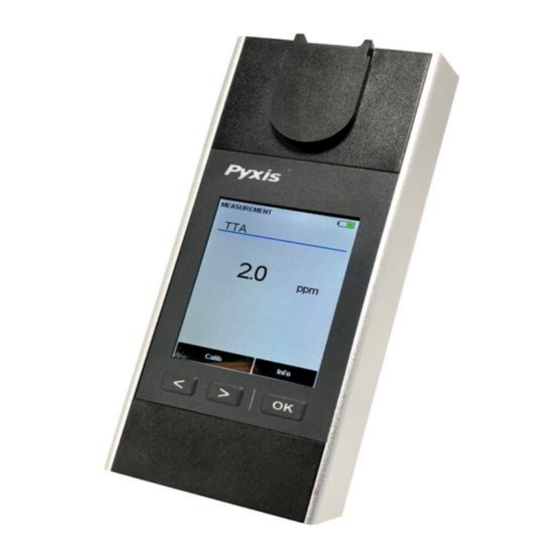
Table of Contents
Advertisement
Quick Links
Advertisement
Table of Contents

Summary of Contents for Pyxis SP-395T TTA
- Page 1 SP-395T TTA Fluorometer Operation Manual Version 1.2 November 2018...
-
Page 2: Table Of Contents
Table of Contents 1. General Description 1.1. Specification 1.2. Pyxis SP-395T Major Features 1.3. Unpacking the Instrument 1.4. Standard Accessories 1.5. Optional Accessories 1.6. Light Shield Cover 2. Start SP-395T 2.1. Battery Installation 2.2. Description of the Control Keys 2.3. Turning On/Off SP-395T... - Page 3 Pyxis Lab Inc. Standard Limited Warranty Pyxis Lab warrants its products for defects in materials and workmanship. Pyxis Lab will, at its option, repair or replace instrument components that prove to be defective with new or remanufactured components (i.e., equivalent to new).
-
Page 4: General Description
IP67, dustproof and waterproof 1.2. Pyxis SP-395T Major Features The Pyxis SP-395T analyzer is an ultraviolet fluorometer. It measures non-halogenated Tolytriazole (TTA) directly without reagent. Main features include: • Sample acidification is not required. TTA measurement is independent of sample pH in the range of 6 to 10. -
Page 5: Unpacking The Instrument
Remove the instrument and accessories from the shipping container and inspect each item for any damage that may have occurred during shipping. Verify that all items listed on the packing slip are included. If any items are missing or damaged, please contact Pyxis Customer Service at service@pyxis- lab.com. -
Page 6: Light Shield Cover
1.6. Light Shield Cover The light shield cover is shown in Figure 1. It should be in the closed position during measurement. 2. Starting SP-395T 2.1. Battery Installation The SP-395T is powered by a 9-volt alkaline battery. Do not use rechargeable nickel cadmium (NiCad) or lithium batteries. -
Page 7: Description Of The Control Keys
2. Replace the battery compartment cover, making sure that the sealing O-ring is lying flat on the battery holder. To prevent the SP-395T from accidently being turned on due to vibration, please firmly tighten the two screws. 2.2. Description of the Control Keys The SP-395T has three keys as shown in Figure 1. -
Page 8: Turning On/Off Sp-395T
60 seconds without user interaction through the keys. 3. Wireless Connection The Pyxis SP-395T can be connected to a smart phone or a computer via Bluetooth/WiFi for upgrading the device software. The SP-395 can be wirelessly paired with other Pyxis devices for exchanging data. -
Page 9: Device Information And Diagnosis
(Figure 5). The information has no use for normal operation. Please provide an image of both the device information screen and the diagnosis screen when you contact Pyxis (service@pyxis-lab.com) for troubleshooting your device. -
Page 10: Tta Measurement
5. TTA Measurement When powered on, the SP-395T will be in the measurement (read) mode (see figure 3). The displayed value is the concentration of TTA. Conversion to Alternate Species = To convert the reading value to Halogenated Azole (HRA), you may multiply your TTA value reading by a factor of 0.75. -
Page 11: Calibration
Calibration of the SP-395T requires deionized water and a standard solution. TTA calibration uses the 1 ppm (TTA 1ppm PN: 57012) or 2 ppm (TTA 2ppm PN: 57013) TTA standard solution. Pyxis Calibration Standards can be purchased at our online Estore/Catalog https://pyxis-lab.com/product-... -
Page 13: Cleaning Procedure For Sp-395T Sample Wall
High stress applications with excessive suspended solids and corrosion/scale by-product can result in the need to increase the frequency of cleaning your handheld device. For field use, Pyxis has developed a custom field cleaning kit for all your Pyxis handheld devices specifically designed to target a wide variety or inorganic deposits and foulants commonly experienced in cooling water applications. - Page 14 Procedure • Soak your handheld device in 10 mL of cleaning kit solution • Allow to soak for 30 minutes • Then use cotton swab or soft cloth to gently remove excessive deposit after soaking • Rinse with DI water then check for flashing blue light inside your handheld device •...
















Need help?
Do you have a question about the SP-395T TTA and is the answer not in the manual?
Questions and answers